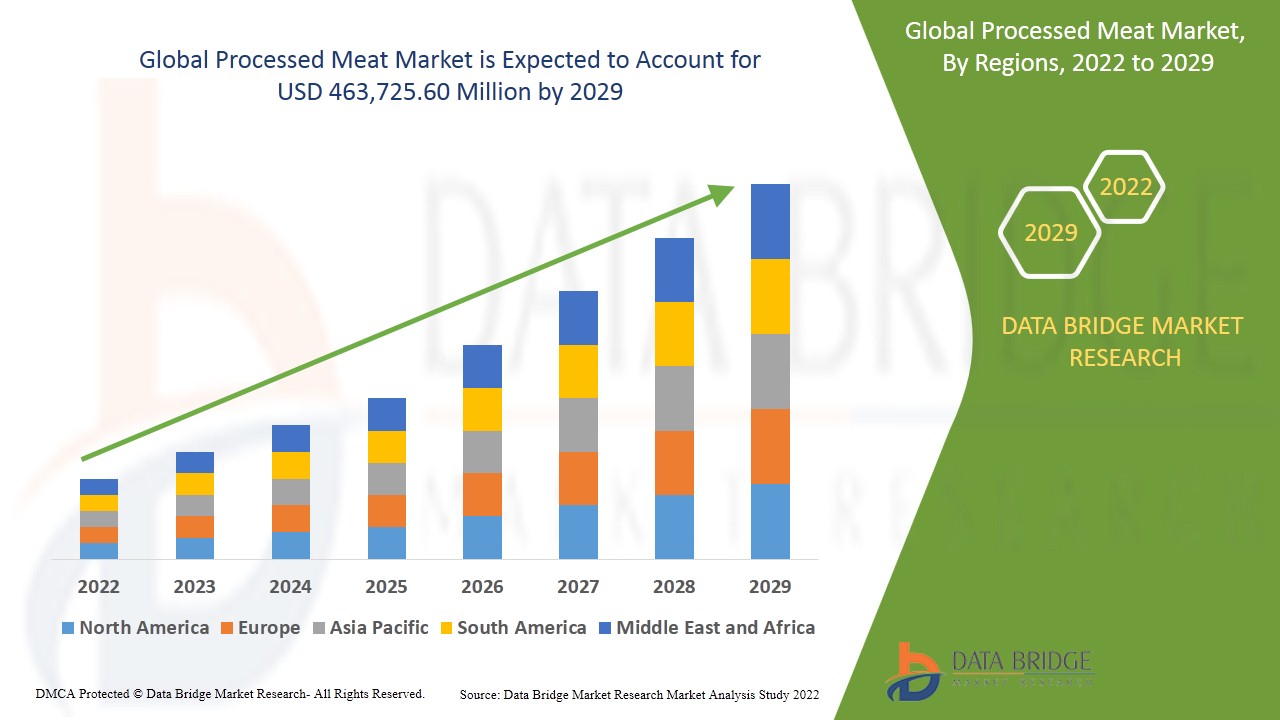
Introduction
The global processed meat market has been experiencing significant growth, driven by factors such as increasing urbanization, changing consumer lifestyles, and a rising demand for convenient and protein-rich food options. Processed meats, including products like sausages, bacon, ham, and deli meats, have become staples in many diets worldwide. This article delves into the current state of the processed meat market, explores key trends and growth drivers, and provides insights into the future outlook of the industry.
Source – https://www.databridgemarketresearch.com/reports/global-processed-meat-market
Market Overview
The processed meat market has shown robust growth in recent years. In 2024, the market was valued at approximately USD 830.02 billion and is projected to reach USD 908.87 billion in 2025, growing at a compound annual growth rate (CAGR) of 9.5%. This upward trajectory is expected to continue, with the market anticipated to reach USD 1,295.12 billion by 2029.
Several factors contribute to this growth:
-
Urbanization and Lifestyle Changes: As more people move to urban areas, lifestyles become busier, leading to increased demand for convenient food options like processed meats.
-
Rising Disposable Incomes: Higher income levels enable consumers to spend more on ready-to-eat and processed food products.
-
Globalization of Food Cultures: Exposure to different cuisines has increased the acceptance and demand for various processed meat products.
Key Market Segments
By Product Type
-
Poultry: Poultry-based processed meats are gaining popularity due to their perceived health benefits and lower fat content compared to red meats.
-
Beef: Beef remains a staple in many regions, with products like sausages and corned beef being widely consumed.
-
Pork: Pork-based products, such as bacon and ham, continue to have a strong market presence.
-
Others: This includes processed meats from lamb, goat, and other sources, catering to specific regional preferences.
By Processing Type
-
Cured: Involves adding preservatives like nitrates to extend shelf life.
-
Smoked: Imparts flavor and preservation through exposure to smoke.
-
Cooked: Products are fully cooked during processing and require minimal preparation.
-
Fresh-Processed: Includes products like sausages that are processed but not cooked.
By Distribution Channel
-
Supermarkets/Hypermarkets: These remain the primary distribution channels, offering a wide variety of processed meat products.
-
Convenience Stores: Cater to on-the-go consumers seeking quick meal options.
-
Online Retail: The rise of e-commerce has made it easier for consumers to purchase processed meats online.
-
Others: Includes specialty stores and direct-to-consumer sales.
Regional Insights
North America
North America holds a significant share of the processed meat market, with the United States being a major contributor. The market in this region is expected to reach USD 15.55 billion in 2025 and grow at a CAGR of 2.45% to reach USD 17.56 billion by 2030. Factors driving this growth include high consumption rates, advanced processing technologies, and a strong presence of key market players.
Europe
Europe is a mature market for processed meats, with countries like Germany, the UK, and France leading in consumption. The region’s market growth is influenced by traditional consumption patterns and a growing demand for premium and organic processed meat products.
Asia-Pacific
The Asia-Pacific region is witnessing rapid growth in the processed meat market, driven by increasing urbanization, rising disposable incomes, and changing dietary habits. Countries like China, India, and Japan are experiencing a surge in demand for processed meat products.
Latin America and Middle East & Africa
These regions are emerging markets for processed meats, with growth fueled by urbanization, population growth, and increasing awareness of processed meat products.
Consumer Trends and Preferences
Health and Wellness
Consumers are becoming more health-conscious, leading to a demand for processed meat products with reduced sodium, fat, and preservatives. Manufacturers are responding by offering healthier alternatives and transparent labeling.
Convenience
The busy lifestyles of modern consumers have increased the demand for ready-to-eat and easy-to-prepare processed meat products. This trend is particularly prominent among working professionals and urban dwellers.
Premiumization
There is a growing market for premium processed meat products that offer higher quality, unique flavors, and artisanal preparation methods. Consumers are willing to pay more for products that provide a superior taste experience.
Sustainability and Ethical Sourcing
Environmental concerns and ethical considerations are influencing consumer choices. There is a rising demand for processed meats sourced from sustainable and humane farming practices.
Technological Innovations
Advancements in food processing technologies are enhancing the quality, safety, and shelf life of processed meat products. Innovations include:
-
High-Pressure Processing (HPP): A method that uses high pressure to eliminate pathogens without the need for chemical preservatives.
-
Modified Atmosphere Packaging (MAP): Extends shelf life by altering the atmospheric composition within packaging.
-
Automation and Robotics: Improve efficiency and consistency in meat processing operations.
Challenges and Concerns
Despite the growth prospects, the processed meat market faces several challenges:
-
Health Risks: Consumption of processed meats has been linked to health issues such as heart disease and certain cancers, leading to negative perceptions among health-conscious consumers.
-
Regulatory Hurdles: Stringent food safety regulations and labeling requirements can pose challenges for manufacturers.
-
Supply Chain Disruptions: Events like pandemics and geopolitical tensions can disrupt supply chains, affecting the availability and cost of raw materials.
Future Outlook
The processed meat market is poised for continued growth, driven by evolving consumer preferences, technological advancements, and expanding global markets. Key strategies for stakeholders include:
-
Product Innovation: Developing new products that cater to health-conscious and ethically-minded consumers.
-
Market Expansion: Exploring untapped markets in developing regions.
-
Sustainability Initiatives: Implementing environmentally friendly practices to meet consumer demand for sustainable products.
Conclusion
The processed meat market is undergoing significant transformation, influenced by changing consumer behaviors, technological innovations, and global economic factors. While challenges exist, the industry’s adaptability and responsiveness to consumer needs position it for sustained growth in the coming years. Stakeholders who prioritize health, convenience, sustainability, and innovation will be well-placed to capitalize on emerging opportunities in this dynamic market.